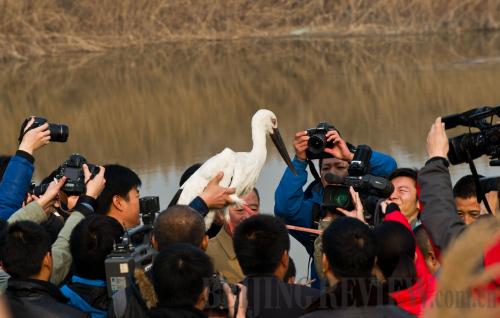|
 |
|
CLEAN BILL OF HEALTH: A volunteer releases an oriental stork into the wild in Tianjin on November 21. Orinthologists treated, tagged and released 13 wild storks that survived poisoning by poachers (YUE YUEWEI) |
Two poaching incidents involving migrating birds have ignited outrage against poachers and brought on calls for intensified enforcement of wild animal protection laws.
A 12-minute documentary posted online on October 15, titled Massacres Along the Millennium Bird Pathway, went viral. In the documentary, poachers in Guidong County in central China's Hunan Province shot migratory birds on hilltops at night and used flashlights to lure birds into snares. The documentary also has scenes of local farmers trying to sell their prey in a local market in day time caught by a hidden camera.
Guidong lies along one of eight routes for the world's billions of migratory birds. Every autumn, clouds of birds fly over local mountains as they travel thousands of miles to roost in India and Southeast Asia.
Billions of birds migrate around the world annually. Three of the world's eight major migratory routes pass through China. But unlike the other two routes passing through the western and eastern parts of China, the middle route, forming a narrow channel in the provinces of Hunan and Jiangxi, features a great density of flocks and has been plagued by rampant poaching activities.
Li Feng, producer of Massacres Along the Millennium Bird Pathway and a reporter with Hunan-based Changsha Evening News, told Xinhua News Agency that local villagers have long regarded captured birds as a delicacy, while hobbyists and smugglers prey on the birds for sport and profit respectively.
According to Li, at local markets in Guidong, birds with longer necks, such as egrets and herons, sell for between 10 yuan ($1.6) and 70 yuan ($11.21), while short-necked eagles and owls are priced at hundreds of yuan each, as the taste of their meat is preferred. Swans can sell for 10,000 yuan ($1,600) apiece. Some birds are then smuggled to large cities in southern Guangdong Province and sold at even higher prices to high-end restaurants.
"Local residents are unaware of the animals' endangered status, not knowing that many of the cheaply priced birds of prey are actually under state protection," Li said. Li, who has reported on the poaching of wild birds in Hunan for two years, said that a village in the counties of Guidong, Xinhua and Xinshao can net up to 150 tons of wild birds a year as such hunting is observed as a tradition due to locals' belief in bird meat's special health benefits.
"Some poachers and smugglers track and kill birds all the way as they depart from Mongolia and fly south," said Yang Jinhai, head of the Forestry Bureau of Xinhua County.
The victim of another bird poaching scandal is the critically endangered oriental stork. No more than 3,000 remain in the wild.
In a wetland reserve in north China's Tianjin Municipality, poachers poisoned migrating oriental storks, leaving 20 dead and 13 others sickened. The birds had stopped at the Beidagang Wetland Nature Reserve on the way from northeast China to the Poyang Lake in central China. An amateur photographer found the storks' bodies on November 11. Ten days later, researchers had tagged and released the 13 fully recovered birds.
Local police authorities said that the waters were confirmed to contain carbofuran, also known by its brand name Furadan, one of the most toxic carbamate pesticides.
A research paper on poaching of waterfowl in China led by Ma Ming, Vice Chairman of the China Ornithological Society, was published in November. Ma's team estimated that between 80,000 and 120,000 waterfowl of around 40 species were poached in China annually and 68 percent of these birds were poisoned. Poachers usually baited the birds with poison-soaked cereal, fish or shrimp. Ironically, restaurant-goers who dined on the exotic birds became severely ill from consuming the tainted meat.
As the rise of poaching activities and professional hunters is largely driven by demands for wild birds in China's urban markets, ornithologists warn of an additional threat on top of traditional hunting and consumption of wild birds in provincial backwaters. "Eating wild birds is dangerous, as it might bring unknown viruses into human society," Deng Xuejian, a Hunan-based ornithologist, told Xinhua.
China adopted the Wild Animal Protection Law in 1988. According to the law, those who hunt, sell, purchase or transport wild animals that are under state protection can be punished and subject to criminal prosecution. In 2000, two farmers were sentenced to 12 years in prison for killing 16 oriental storks, six ducks and two herons.
However, most poachers brazenly ignore the law due to lax law enforcement.
| 